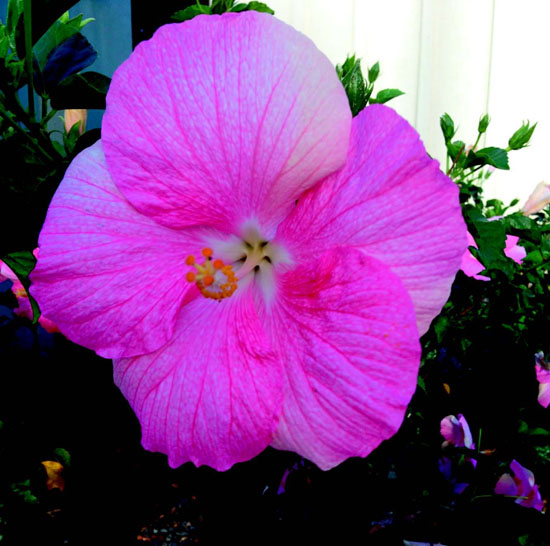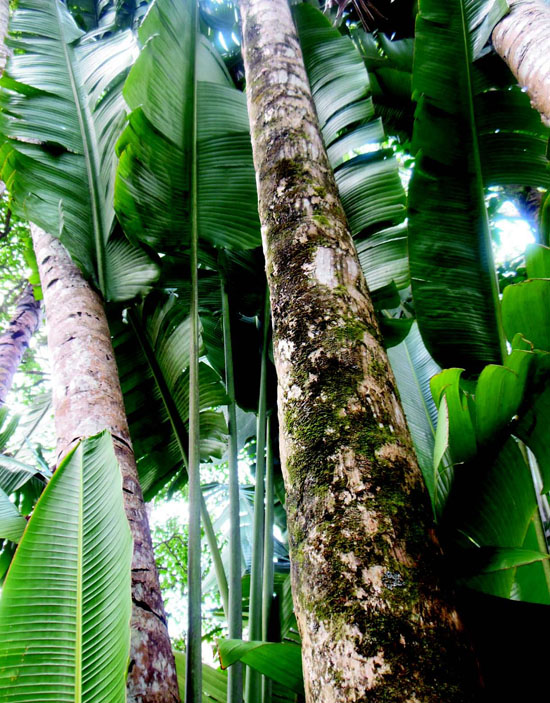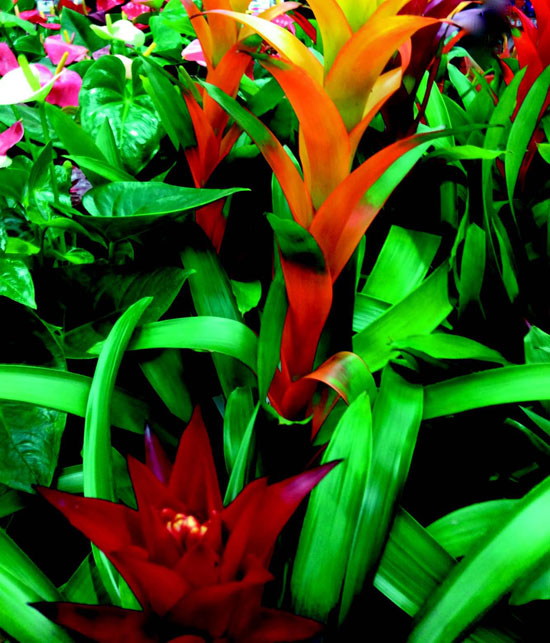 | | | Plant a few bird of paradise to enjoy the feeling of the tropics. Photos Cynthia Brian | | | | | | "God has given us a world that nothing but our own folly keeps from being a paradise." - George Bernard Shaw
 For many people, including myself, sometime between February and March, I have an insatiable urge to experience the exotic romance of a tropical island. I want to feel the sand between my toes, listen to the waves pounding against the shore, smell the seaweed-tainted salt air and soak up the sun. I yearn to snorkel with turtles, swim with sharks and perfume my hair with plumeria. As winter wanes and spring sprouts, hammocks beckon. In paradise, the landscape is lush with flowers, trees, and vines that we normally only experience in botanical gardens. But what if we can't take a trip to a fantasy island? How can we plant a piece of paradise in our personal places to release that fabulous feeling of leisure?
For many people, including myself, sometime between February and March, I have an insatiable urge to experience the exotic romance of a tropical island. I want to feel the sand between my toes, listen to the waves pounding against the shore, smell the seaweed-tainted salt air and soak up the sun. I yearn to snorkel with turtles, swim with sharks and perfume my hair with plumeria. As winter wanes and spring sprouts, hammocks beckon. In paradise, the landscape is lush with flowers, trees, and vines that we normally only experience in botanical gardens. But what if we can't take a trip to a fantasy island? How can we plant a piece of paradise in our personal places to release that fabulous feeling of leisure?
 Here is a smattering of simple ways that you can plant the aloha spirit into your spring swing.
Here is a smattering of simple ways that you can plant the aloha spirit into your spring swing.
 Palms
Palms
 Nothing says "tropical" more than palm trees! When I built my home in Lamorinda, the first two trees I planted in containers were palms. Now planted at the top of my driveway, the two lovers are well over 30 feet, their fronds swaying in the wind to welcome me home. There are numerous varieties of palms to choose from including lady, queen, date, coconut, bamboo, sago and many more, depending on what you desire in height, hardiness, leaf structure and upkeep.
Nothing says "tropical" more than palm trees! When I built my home in Lamorinda, the first two trees I planted in containers were palms. Now planted at the top of my driveway, the two lovers are well over 30 feet, their fronds swaying in the wind to welcome me home. There are numerous varieties of palms to choose from including lady, queen, date, coconut, bamboo, sago and many more, depending on what you desire in height, hardiness, leaf structure and upkeep.
 Bird of Paradise
Bird of Paradise
 When my daughter and I went on "the college tour," what enamored her most about San Diego were sunshine, surf, palm trees and birds of paradise - four ingredients of kick back island living. Hardy in zones 9-12, bird of paradise are remarkably easy to grow in our area as long as the plants get four or more hours of direct sunlight with good drainage. They prefer temperatures of 50 degrees and above, but I've had no problem growing them even when the thermometer dips below freezing. If planted from seed, they will take seven or more years to bloom, otherwise, expect to wait three or four years. They afford exquisite, long lasting cut flowers.
When my daughter and I went on "the college tour," what enamored her most about San Diego were sunshine, surf, palm trees and birds of paradise - four ingredients of kick back island living. Hardy in zones 9-12, bird of paradise are remarkably easy to grow in our area as long as the plants get four or more hours of direct sunlight with good drainage. They prefer temperatures of 50 degrees and above, but I've had no problem growing them even when the thermometer dips below freezing. If planted from seed, they will take seven or more years to bloom, otherwise, expect to wait three or four years. They afford exquisite, long lasting cut flowers.
 Hibiscus
Hibiscus
 When you are looking for high impact tropical flair with low maintenance, you can't beat the show-stopping hibiscus. Easy to grow and available in a kaleidoscope of colors, hibiscus enjoys temperatures up to the 90s but doesn't do so well under 30 degrees. Hibiscus can be trimmed into gorgeous hedges or used as a moveable container plant.
When you are looking for high impact tropical flair with low maintenance, you can't beat the show-stopping hibiscus. Easy to grow and available in a kaleidoscope of colors, hibiscus enjoys temperatures up to the 90s but doesn't do so well under 30 degrees. Hibiscus can be trimmed into gorgeous hedges or used as a moveable container plant.
 Ferns
Ferns
 When we think of ferns, we often are reminded of redwood forests or Victorian parlors. In the rain forests, many varieties of ferns grow wild in filtered light where they thrive on humidity and moisture. Propagated by spores, I grow maidenhair, walking, sword and other hardy ferns in my outdoor landscape, using them often in my floral arrangements.
When we think of ferns, we often are reminded of redwood forests or Victorian parlors. In the rain forests, many varieties of ferns grow wild in filtered light where they thrive on humidity and moisture. Propagated by spores, I grow maidenhair, walking, sword and other hardy ferns in my outdoor landscape, using them often in my floral arrangements.
 Traveler's Tree
Traveler's Tree
 I bet this specimen stumps you! Ravenala madagascariensis was named because its long leaf sheaths accumulate a quart of water, often used for drinking in emergencies by travelers. This Madagascar native has a trunk that resembles a palm and fronds that look like banana leaves, yet it is a member of the bird of paradise family boasting white flowers. In the tropics, the traveler's tree will grow to 30 feet, but in my three large ceramic deck pots, it reaches a perfect height of about eight feet, dying back in a winter freeze.
I bet this specimen stumps you! Ravenala madagascariensis was named because its long leaf sheaths accumulate a quart of water, often used for drinking in emergencies by travelers. This Madagascar native has a trunk that resembles a palm and fronds that look like banana leaves, yet it is a member of the bird of paradise family boasting white flowers. In the tropics, the traveler's tree will grow to 30 feet, but in my three large ceramic deck pots, it reaches a perfect height of about eight feet, dying back in a winter freeze.
 Bromeliads
Bromeliads
 What is not to love about these perennial monocotyledons? In tropical settings, we see them attached to trees, structures, or growing like pineapples. In California, they are usually used as houseplants requiring minimal maintenance. They thrive outdoors in the heat as long as the weather remains above freezing. Their brilliant bracts maintain color for six months or more and each rosette blooms only once. As the mother is dying, pups are born, repeating the cycle. Fill the cup on the top of your bromeliad with water when necessary without watering the soil.
What is not to love about these perennial monocotyledons? In tropical settings, we see them attached to trees, structures, or growing like pineapples. In California, they are usually used as houseplants requiring minimal maintenance. They thrive outdoors in the heat as long as the weather remains above freezing. Their brilliant bracts maintain color for six months or more and each rosette blooms only once. As the mother is dying, pups are born, repeating the cycle. Fill the cup on the top of your bromeliad with water when necessary without watering the soil.
 Anthuriums
Anthuriums
 Originally from Central and South American tropical rain forests, now a mainstay in the Hawaiian Islands, anthuriums flourish with heat, humidity, filtered light and good drainage. Colors include red, pink, white, orange and green. Combine them with other tropicals for a rich tapestry of vacation envy.
Originally from Central and South American tropical rain forests, now a mainstay in the Hawaiian Islands, anthuriums flourish with heat, humidity, filtered light and good drainage. Colors include red, pink, white, orange and green. Combine them with other tropicals for a rich tapestry of vacation envy.
 Jungle Fowl
Jungle Fowl
 In the islands, jungle fowl roam freely. The magnificently feathered roosters are protective of their girls and offspring. Chickens are the domesticated version of these jungle birds. Although the boys may not be welcome in your neighborhood, the hens will deliver fresh eggs while fertilizing and tilling your landscape. Peacocks are another beautiful bird in paradise. I grew up raising chickens and peacocks. While my egg business paved the way to my college education, the peacocks provided endless entertainment with their constant preening around anyone or anything they perceived to be female, including our ornamental cement ducks.
In the islands, jungle fowl roam freely. The magnificently feathered roosters are protective of their girls and offspring. Chickens are the domesticated version of these jungle birds. Although the boys may not be welcome in your neighborhood, the hens will deliver fresh eggs while fertilizing and tilling your landscape. Peacocks are another beautiful bird in paradise. I grew up raising chickens and peacocks. While my egg business paved the way to my college education, the peacocks provided endless entertainment with their constant preening around anyone or anything they perceived to be female, including our ornamental cement ducks.
 Koi Pond
Koi Pond
 Experience the luxury of getting up close and personal with friendly, curious, colorful fish by installing a koi pond, probably the most popular of all garden installations. With proper filtering, aerating and feeding, you will enjoy years of exotic water entertainment.
Experience the luxury of getting up close and personal with friendly, curious, colorful fish by installing a koi pond, probably the most popular of all garden installations. With proper filtering, aerating and feeding, you will enjoy years of exotic water entertainment.
 These are just a few ways to bring a slice of foreign fun to your home. There are hundreds of dramatic plants to introduce into your tropical design including begonias, orchids, amaryllis, bamboo, lilies, bougainvillea, mandevillas and vines of every sort. Keep in mind that many of the indoor plants we purchase at our favorite nursery or garden center are actually grown in the wild in tropical climates. Even if you don't decide to create a tropical paradise outside, you can always transport the tropics indoors to enjoy a bit of paradise. Finally, don't forget the importance of a water feature and attracting the birds.
These are just a few ways to bring a slice of foreign fun to your home. There are hundreds of dramatic plants to introduce into your tropical design including begonias, orchids, amaryllis, bamboo, lilies, bougainvillea, mandevillas and vines of every sort. Keep in mind that many of the indoor plants we purchase at our favorite nursery or garden center are actually grown in the wild in tropical climates. Even if you don't decide to create a tropical paradise outside, you can always transport the tropics indoors to enjoy a bit of paradise. Finally, don't forget the importance of a water feature and attracting the birds.
 Spring has sprung so why not bring the romance, adventure and luxury of a vacation hideaway to your piece of heaven. Kick off your mud boots, grab your flip flops and sun tan lotion, tuck a bright pink hibiscus blossom in your hair and find paradise in your continental backyard.
Spring has sprung so why not bring the romance, adventure and luxury of a vacation hideaway to your piece of heaven. Kick off your mud boots, grab your flip flops and sun tan lotion, tuck a bright pink hibiscus blossom in your hair and find paradise in your continental backyard.
 Cynthia Brian's Mid-Month Reminders
Cynthia Brian's Mid-Month Reminders
 CHECK out the new science based app, Tomato MD, which helps gardeners identify more than 35 diseases, insects or disorders of tomatoes. The demo version is free; the full version is $2.99 from Apple App store or Google Play.
CHECK out the new science based app, Tomato MD, which helps gardeners identify more than 35 diseases, insects or disorders of tomatoes. The demo version is free; the full version is $2.99 from Apple App store or Google Play.

 ALLOW spent daffodils and narcissus to dry as they are. Do not cut or you won't have any flowers next season.
ALLOW spent daffodils and narcissus to dry as they are. Do not cut or you won't have any flowers next season.

 PICK bouquets of freesia, bearded iris, and jasmine for a fragrant centerpiece.
PICK bouquets of freesia, bearded iris, and jasmine for a fragrant centerpiece.

 ADD nitrogen to boost the growth of all your plants.
ADD nitrogen to boost the growth of all your plants.

 COME to the Be the Star You Are!(r) Book Bash Blow Out on April 25 at 5A Rent A Space to pick up your free seeds and complimentary potpourri. For information, visit http://ow.ly/K3zXG.
COME to the Be the Star You Are!(r) Book Bash Blow Out on April 25 at 5A Rent A Space to pick up your free seeds and complimentary potpourri. For information, visit http://ow.ly/K3zXG.

 (c)2015
(c)2015
 Cynthia Brian
Cynthia Brian
 The Goddess Gardener
The Goddess Gardener
 Starstyle(r) Productions, llc
Starstyle(r) Productions, llc
 Cynthia@GoddessGardener.com
Cynthia@GoddessGardener.com
 www.GoddessGardener.com
www.GoddessGardener.com
 925-377-STAR
925-377-STAR
 I am available as a speaker, designer, and consultant.
I am available as a speaker, designer, and consultant.

|




